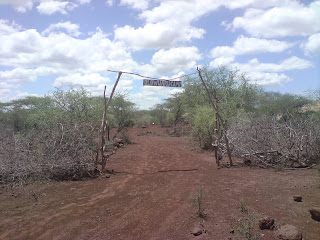The following morning, after hot showers and a full breakfast of sausage, eggs and bacon, Ruben announced we would walk to Loitokitok, the nearby town while he organised another car and driver. Our landy (known by its vrm of KSM---) needed spare parts from Nairobi, so we would not see Simba for a little while.

In the crisp morning sunlight, we took in the wonderful grounds of the lodge for a short while, before setting off on the short walk into town. After so many hours sat-down travelling, and with the hot sun and high altitude, we were all soon breathing deeply and starting to sweat.
Villagers continued to wave at us, shouting a cheery "Jambo", and the children squealed with delight, often waving, with the youngest occasionally "playing shy" before jumping out and waving frantically.
Unlike many places we were later to visit, we were never hassled to buy/give/donate. With many volunteer projects operating in the area, mzungu's were accepted as welcome visitors, it seemed, rather than tourists. It was real Africa, not the tourist affected image.
 Loitokitok would be become our main town, where every Saturday we would take a two hour drive for supplies and to charge cameras, and if possible, use the internet.
Loitokitok would be become our main town, where every Saturday we would take a two hour drive for supplies and to charge cameras, and if possible, use the internet.Smaller than many UK villages, Loitokitok was a hive of activity, its dirt-streets busy with people, motorcycles, 4X4's, goats, chickens, and its central market bustling with vibrant colours, sounds and smells, as people came from villages miles away to buy everything from fruit to batteries, 2nd hand shoes to bike-parts and chickens.
At Loitokitok we met John, a Masai dressed in western clothes who would be our guide-cum-fixer whenever we arrived into town.
After a car was sorted, we returned to the lodge for lunch, before starting our 2 hour drive to camp.
When approaching a small cluster of buildings (and a mobile phone mast- they were everywhere!), Sammi turned off the main road, onto a track that eventually became off-road completely, before finally stopping at a steep bank of a river.
The river itself was very small, but the banks long and steep, partly made of volcanic rock, deposited by Mt Kilimanjaro some 2.5 million years ago. Dressed in the typical bright red of the Masai, a woman was hunched over, hands in the water, further up-stream, equally brightly coloured Shuka (Masai clothes) spread out on the volcanic-rock riverbank drying behind her.
Sammi, finishing his appraisal of the river bank approach, put the landy in gear and eased the vehicle down, through the river, and swiftly up the other side. I hadn't thought it possible at the time, such was the steepness of the riverbanks, and the soft mud of the river. However our amazement didn't last, as we found ourselves crossing that river nearly every day.
We drove for a further short distance still off-road, before driving through a gap in an acacia-bush fence and into the camp.

The camp was quite spacious, with a communal dining area shaded by a canvass roof and a wicker-wall, situated next to a wicker and canvass built kitchen. Our tents were large 3-man green canvass jobs, tall enough to stand up in, and sheltered by either a canvass or traditional thatch "over-roof".
 Each tent had two or three small chairs sat outside on cleanly-swept groundmatts, where I spent many evenings sitting quietly replenishing my fluid loss and watching the sun set behind Mt Kilimanjaro.
Each tent had two or three small chairs sat outside on cleanly-swept groundmatts, where I spent many evenings sitting quietly replenishing my fluid loss and watching the sun set behind Mt Kilimanjaro.Toilets were cess-pits arrangements, with either a little tent and toilet seat, or a mud-built double toilet, with thatched roof. We even had showers- small canvass cubicles with a bucket suspended above with a shower-nozzle attached. The water collected from the river would be heated on the campfire by those not on the afternoon foot-safari, so we even had hot-showers!
From this point on, our routine at camp was roughly as follows:
6.30-7am: breakfast, immediately followed by the morning drive. This was completely off road,
recording wildlife sightings as we go, usually heading to observation hills which we would climb to look for the big animals such as Elephants, Giraffe etc. Our job was to record sightings of all wildlife, the GPS co-ordinates, and details of what the animal/s were doing, to study the migration of the lions prey.
12-4pm; Free time, usually doing our washing, chatting to our Masai guides, and project leaders, and just relaxing.
4pm-6ish; Foot safari. Walking with James, our Masai project leader (always armed with a spear, should the worse happen) to other observation hills, which we would climb and scan the surrounding landscape with binoculars, finding giraffe, wart-hog, lesser kudus etc. This was brilliant, and it was shocking how easier it got every day to power up and down the hills in the heat, rocky conditions, and around the ever present "wait-a-bit" bushes. It was certainly my favorite part of the day.
6-10pm, shower, dinner, and a beer or two by the campfire. There we would hear zebra, elephants tearing down trees and creating a fuss, hyenas, even lions roaring, literally right outside out camp, all under the most vibrant night sky I have ever seen. The animals were the only noise we heard really, save the occasional Masai singing as they go about their business. We had a Masai warrior village a kilometer or so away, and they were our only neighbors.
The weekends were spent visiting Loitokitok on saturday, and doing the data collation on sundays.
It was amazing, a truly amazing place. It was real bush, in the Masai ranchlands, with the local Masai as our friends and neighbours. It felt like home in minutes.
No comments:
Post a Comment